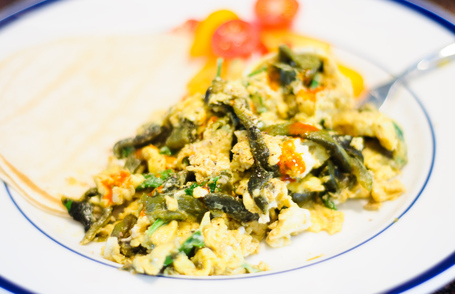Scrambled Eggs With Epazote And Poblanos

Scrambled eggs with epazote and poblanos
Epazote is an absolutely common, everyday herb in many parts of Mexico, Central and South America, but it is barely known in the United States outside of Latin American communities. It is worth your while to track down, as the flavor is utterly unique. If you take bite of the raw leaf, it is resinous (like rosemary), citrusy, herbal and vegetal all at once, with maybe a hint of gasoline! Diana Kennedy and Rick Bayless both say there is no substitute for it, and I have to agree.
Cooked quickly, like in the scrambled eggs above, the fresh flavors mellow to something palatable and exciting. But throw a handful into slowly cooked black or refried pinto beans, and you get an inexplicable, almost meaty flavor. People will tell you they are the best beans they have ever tasted, but they won’t be able to say why. And as a bonus, it is thought to be a carminative, reducing the wind-inducing nature of said legumes.
Your best bet for finding epazote in the US is to visit a Mexican grocery and ask. There is a good chance they might have small packages tucked away in a refrigerator. It is perfectly fine to use when quite wilted, it just shouldn’t be turning black or moldy. It apparently is a common weed in North America, so if you know what to look for, it might be free or very easy to grow. I haven’t tried the dried version, but it is hard to imagine it would be very good.
I was going to write you out a recipe for scrambled eggs with epazote, but that hardly seems necessary. You know how to scramble eggs. For every two eggs, just beat in maybe a tablespoon of chopped epazote leaf. So much the better if you have leftover roasted poblano strips (rajas) from the Achiote-rubbed Butternut Squash Tacos – throw in a hearty handful of them too. Serve with steaming-hot corn tortillas, salsa or hot sauce, and cotija cheese if you have it.


I’ve been reading about epazote for years (my first source was Mexican Light which is a really great cookbook despite the name! and has a good bit of veggie options) but funnily enough never actually found it until I moved from the Southwest to the Pacific Northwest. I have yet to try the bean thing although Mexican Light recommends much the same for bean-making. I have a big batch of black beans to get through and will try after that. I will be sure to scramble up some eggs while I’ve got it!
My new bean trick has been – per Russ Parsons – dried chipotle peppers cooked with the beans to give them a smokey, also almost meaty flavor. Have you ever tried both chipotle and epazote in the same batch of beans? I assume they would work well together but will have to experiment to see if I am right.
Epazote is a great herb. I love chopping it and mixing it with corn/onion/peppers. I’ll try it with eggs too now. Yum.
Epazote is also very, very easy to grow. It self-seeds like crazy and grows everywhere. It will grow through cracks in the sidewalk if a seed happens to blow in there… really, really easy to grow.
Now you have me totally curious. I wonder if I could track down seeds and grow the herb myself? I’m on the hunt for more variety in my herb garden next year. This might be a wonderful experiment. (Love your blog, by the way. I found you through The Kitchn, and I look forward to coming back!)
I concur, this is an awesome herb.
Leslie – I’m sure epazote and chipotle would be quite compatible. You might have to experiment to find a balance that would allow you to taste both.
Cindy – it sounds good with the corn mixture, and thanks for the growing tips.
Alison – well, looks like Cindy has our answer! Thanks for coming by via The Kitchn, they do a nice job.
I use dried epazote when cooking black beans, the same way you’d use asafoetida in an Indian recipe or kombu in a macrobiotic recipe–it supposedly helps with digestion. I’ve used it with chipotle, but the dried epazote doesn’t impart quite as much flavor as the fresh so the chipotle really takes over.
Ok…I admit it, I have never heard of Epazote . Now I’m going to have to track it down and try it out.
oops. forgot to sign in with name…
Ok…I admit it, I have never heard of Epazote . Now I’m going to have to track it down and try it out.
As several people mentioned, epazote is very easy to grow. Seeds are available from several vendors and nurseries. As it has grown more popular, some sources also sell plants (possibly the Tilth Edible Plant Sale, held every spring at the Good Shepherd Center in Seattle). The plants like hot weather (i.e. they don’t come up until the weather warms up), and if you let them go to seed you will have more next year.
The Hardy Plant Society of Washington (www.hardyplantsocietywa.org) has a seed exchange, and there is usually epazote seed (listed as Chenopodium ambrosioides) available for around $1 per packet. The seeds are sold at HPSW meetings, at their two plant sales, at the Arboretum Foundation spring plant sale, or contact them directly.